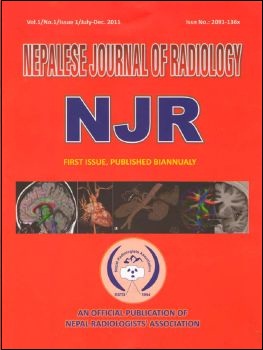Radiological Evaluation of Orbit in cases of Proptosis in Eastern Nepal
DOI:
https://doi.org/10.3126/njr.v1i1.6316Keywords:
Computed tomography, Proptosis, Ocular and orbital tumoursAbstract
Aim: Proptosis is a common problem, encountered in ophthalmic outpatient department (OPD) requiring radiological evaluation for early diagnosis and to know the extent of involvement. This study was carried out to analyse the spectrum of diseases, which manifested as proptosis in eastern Nepal. Role of Computed tomography (CT) and early diagnosis is emphasised.
Materials and Methods: All the patients referred to the radiology department for the evaluation of proptosis either by plain radiography, ultrasonography (USG) and CT over the period of two years were included.
Results: There were 143 eyes with proptosis (including due to acute trauma), which underwent CT scan and in many of them USG and colour doppler examination were also done. Ocular and orbital tumours were most common cause of proptosis accounting for 36.36% (52) of cases followed by pseudotumour and infection 22.37% (32).
Conclusion: Many of the cases of proptosis in this part of Nepal were neglected presenting late in advanced stage of disease requiring extensive surgery. This calls for early CT evaluation of the cases of proptosis and prompt management.
DOI: http://dx.doi.org/10.3126/njr.v1i1.6316
Nepalese Journal of Radiology Vol.1(1): 8-14
Downloads
Downloads
Published
How to Cite
Issue
Section
License
This license enables reusers to distribute, remix, adapt, and build upon the material in any medium or format, so long as attribution is given to the creator. The license allows for commercial use.




